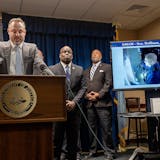Health care workers Saturday staged a protest in front of the Brooklyn Center Police Department over the use of so-called less-lethal riot-control weapons following a week of clashes between police and civilians.
Protests over former officer Kim Potter's killing of 20-year-old Daunte Wright have featured nonviolent marches and demonstrations but also brick-throwing and fireworks. Police have responded with flash-bang grenades, rubber-coated bullets, tear gas and mass arrests.
Some of those people struck by police projectiles, including a Star Tribune photojournalist, have needed emergency medical care.
Victor Ramirez, a 19-year-old who protested multiple nights, was shot Tuesday with a projectile that narrowly missed his left eye and fractured a bone.
"These weapons are being used on people that don't have no weapons in their hands," Ramirez said. He said he's tired of police "saying that they're scared when they have full body armor, when they're the ones with these guns."
In February, University of Minnesota medical student Erika Kaske published a study in the New England Journal of Medicine analyzing projectile injuries stemming from civil unrest over the death of George Floyd.
A review of records from Hennepin Healthcare and M Health Fairview found 89 emergency room visits, including seven people hit directly by tear gas canisters, 10 people struck in the eye and three blinded. In 40% of emergency room visits, the patient had been struck in the head, contrary to U.N. guidance on such projectiles.
Kaske said the study was motivated by a teenage patient under 18 who was shot and suffered a skull fracture with bone fragments affecting the brain, forcing urgent neurosurgery.

![A black bear stopped after crossing Big Bay Road on Madeline Island, the largest of the Apostle Islands in Wisconsin, on Monday, May 31, 2021. ]](https://arc.stimg.co/startribunemedia/PWNYGIY3WTSWDBOGOYD775DPP4.jpg?&w=80&ar=1:1&fit=crop)

